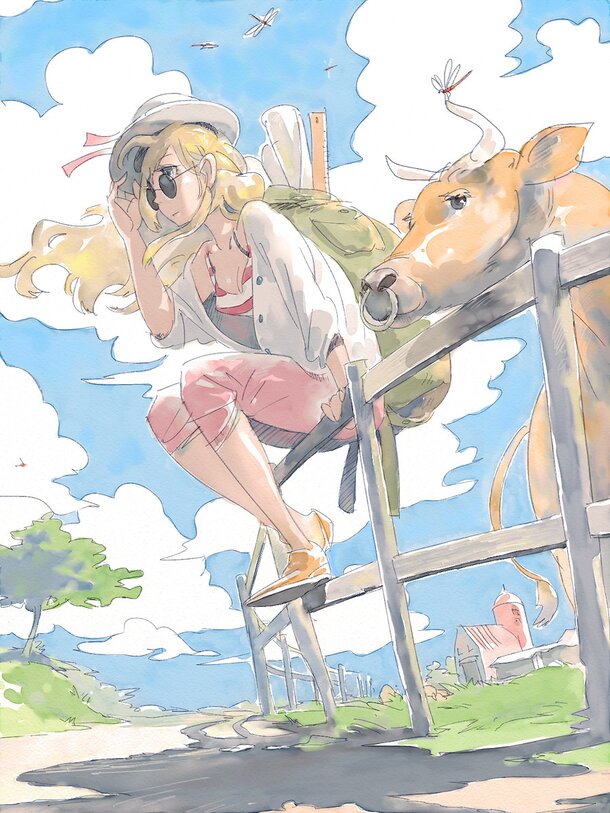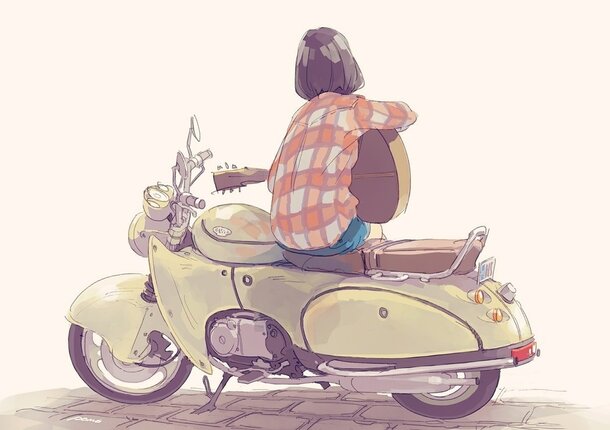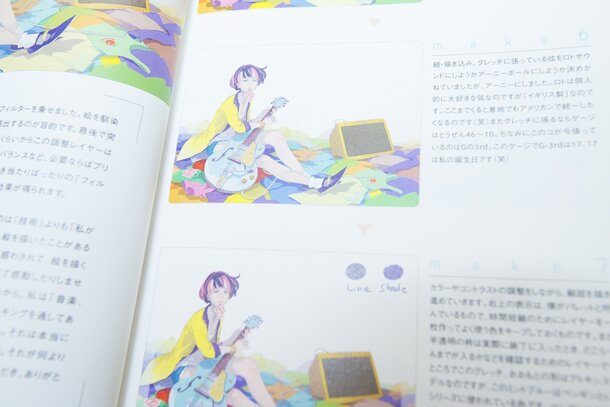**The World in the Rest**
——This is related to our earlier conversation about working on commercial music, but you came up with a concept in the book of “The World in the Rest.” A quarter note and sixteenth note, among others… there are various notes, but why a rest?
P: In general, music has a score. Scores exist as a piece of music’s “blueprint.” It’s the normal language like “composer” or “performer.” I’ve come to think that when you see a score, it has a lot of things in common with pictures. Like while composing with quarter notes or forming the basic silhouette of a rhythm, the atmosphere and wholeness of a whole note… When I draw while thinking about that, I noticed the rest. Like when you have a three-beat break between two notes in a song, it’s not that you don’t have anything there, it’s just the “space” needed as a part of that song’s expression. It’s just like the blank spaces in a picture - it’s not that there’s nothing drawn there, it’s the “space” necessary as a part of that piece’s expression.

*Cow Girl - A Country Road in the Beginning of Autumn © pomodorosa. “Featuring a soft, refreshing atmosphere. At first glance it has a casual, relaxing design, but in addition to the fine line art left behind, the uneven coloring is an important point. If the colored parts are music, then the uneven coloring is the articulation, and the blank spaces are rests. This lively way of drawing is a strong method.” (Translated extract from the collection, p. 88)*
——So the blank space in pictures resembles music rests.
P: Right. If a song just kept going on note after note, would that sound like music? Pictures are the same. If an entire canvas is painted black, that’s like a song without rests being filled with whole notes. I thought, “How many people would see that as a picture?” I think both pictures and music include rests.
——A work comes out of its “space.”
P: I feel like in that way, music and illustrations are similar. Once, I had the opportunity to assist Yoko Kanno 1 with her arrangement on some music for anime. As I saw the way people work at a studio, I found myself moved, thinking, “Wow… She’s really a master at using music rests…” She treats those breaks with a lot of importance. Of course, even in melodies, you can hear a lot of innovation in the treatment of rests.

I don’t really like scores filled with notes. They want a song to be thick with sixteenth notes neatly lined up for the vocals, guitar, bass, pad, and chorus that keeps on ringing so it’s difficult to take a breather, but if it has too many layers, it sounds like it came from an LFO, right? (laughs) I keep telling myself to compromise.
Mixes are like that, too. I think more and more people use their iPhones and smartphones as players with earphones and headphones nowadays, but when you listen closely and the music is loud, you stand out, right? I joke that the trend of these kinds of mixes is a sound pressure competition, but generally there are more and more loud songs without openings. They might have some appeal, but you get tired of them and can’t listen to them for long, and even if it’s good, I don’t think you’ll want to listen to it again and again.

It’s like how flavors [in cooking] can be strong, when you get used to a strong flavor and you can’t accept anything bland. People listen to a lot of music, but because of that there aren’t as many songs that you can still “taste” for a long time, so it’s the natural flow of things I guess. If you make good bouillon soup, even if you don’t flavor it with this and that, it’s perfectly good. Doesn’t food like that leave more of an impression than dense fast food? Just use raw materials. Whether it’s pictures or music, that’s what I’m aiming towards.
——Is that thought of “making use of raw materials” found in your illustrations, as well?
P: Take a line, for example. I put a lot of importance on this. At first glance it might look sloppy, but I came to this line after lots of trial and error. In that way, I’m extremely careful about how I draw lines.
I’m referencing the book, as well, but as a matter of convenience this is called a “rough,” and I could do a pretty, clean copy, but for me, sometimes I can’t draw lines beyond this “rough.” The cleaner I draw it, the more the energy and personality dies. Careful is not the same as clean.
With raw ingredients in cooking, for example, I prefer fresh vegetables picked from a field, even if they have some dirt on them, to having all the washed vegetables of every sizes lined up.

*M51 MODS COAT © pomodorosa. “Take a line, for example. I put a lot of importance on this. At first glance it might look sloppy, but I came to this line after lots of trial and error. In that way, I’m extremely careful about how I draw lines.”*
Producing the “Initial Impulses Are Good” Works
——The “making” page of the second half of the book is interesting. Incidentally, what was the most important thought or feeling in these works?
P: I put importance on that feeling of “I want to…” That feeling behind, “I want to draw a guitar,” or, “I want to draw a girl’s ponytail.” When you draw with those feelings you think, oh, it’s a composition! A rough sketch! A color scheme! Sometimes, it falls through, though. “Oh, it’s just a rough sketch, but I drew this really cute girl, but if I complete it…” I’m sure other people will relate (laughs) but that initial early impulse of what you wanted to draw when you started, and the enjoyment behind starting that. Works that are okay even if they’re blurry are naturally completed, too, I think.

*“The guitar is a Gretsch. When I think Gretsch, I think Brian Setzer, I think neo-rockabilly and new wave. Neo-rockabilly and new wave make me think of the ‘80s, and then short hair with bangs and a jacket. In that way I’m led to characters by instruments." (Translated excerpt from the collection, p. 95 “make1” text)*
——Looking forward, what’s your objective or what job are you working hardest on?
P: I eventually want to make music that plays during an anime. I can finally manage illustrations and music, so I’d like to do character design or music at some point. Also, this is just related to me, but in April I became a father to twins.
——Congratulations!
P: Hahaha, thank you. Recently, [their growth] has started influencing my drawings. As they turn 2 or 3 they might start affecting them more.
——How have they been affected?
Recently, I’ve started thinking that boys are cute. Maybe next time I’ll draw with a “Music × Boys” theme. (laughs)

Pomodorosa Work Collection - Music, Fashion and Girl Sale Page
pomodorosa’s Official Site
pomodorosa’s Official TOM Portfolio Page
^1^ A Japanese music producer, composer, and arranger. From anime and TV dramas to movies, she has worked on a wide variety of genres. For anime, she has been in charge of the music for series including Turn A Gundam and Ghost in the Shell: Stand Alone Complex.
This is a Tokyo Otaku Mode original article.

 Shopping Guide
Shopping Guide



